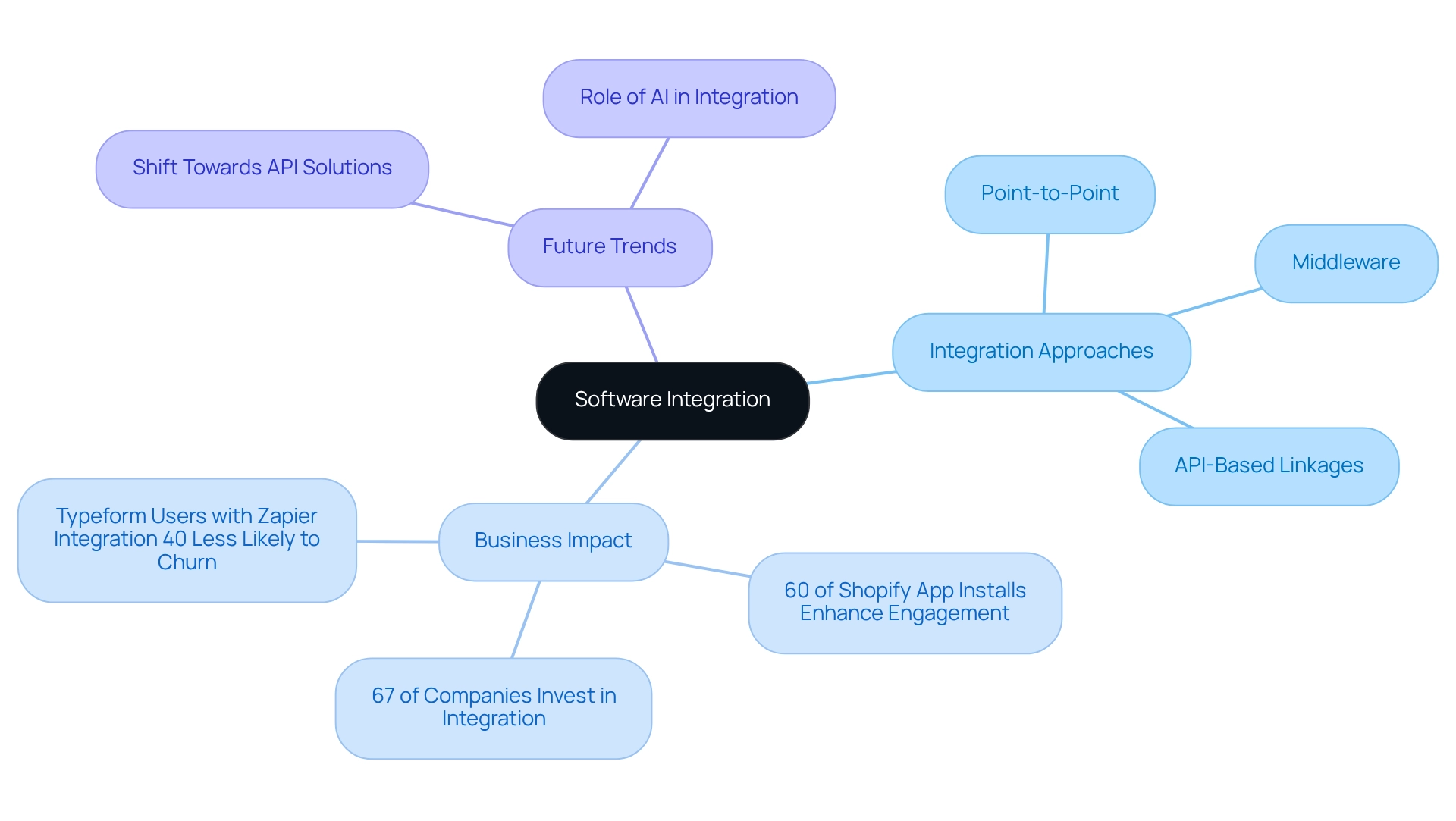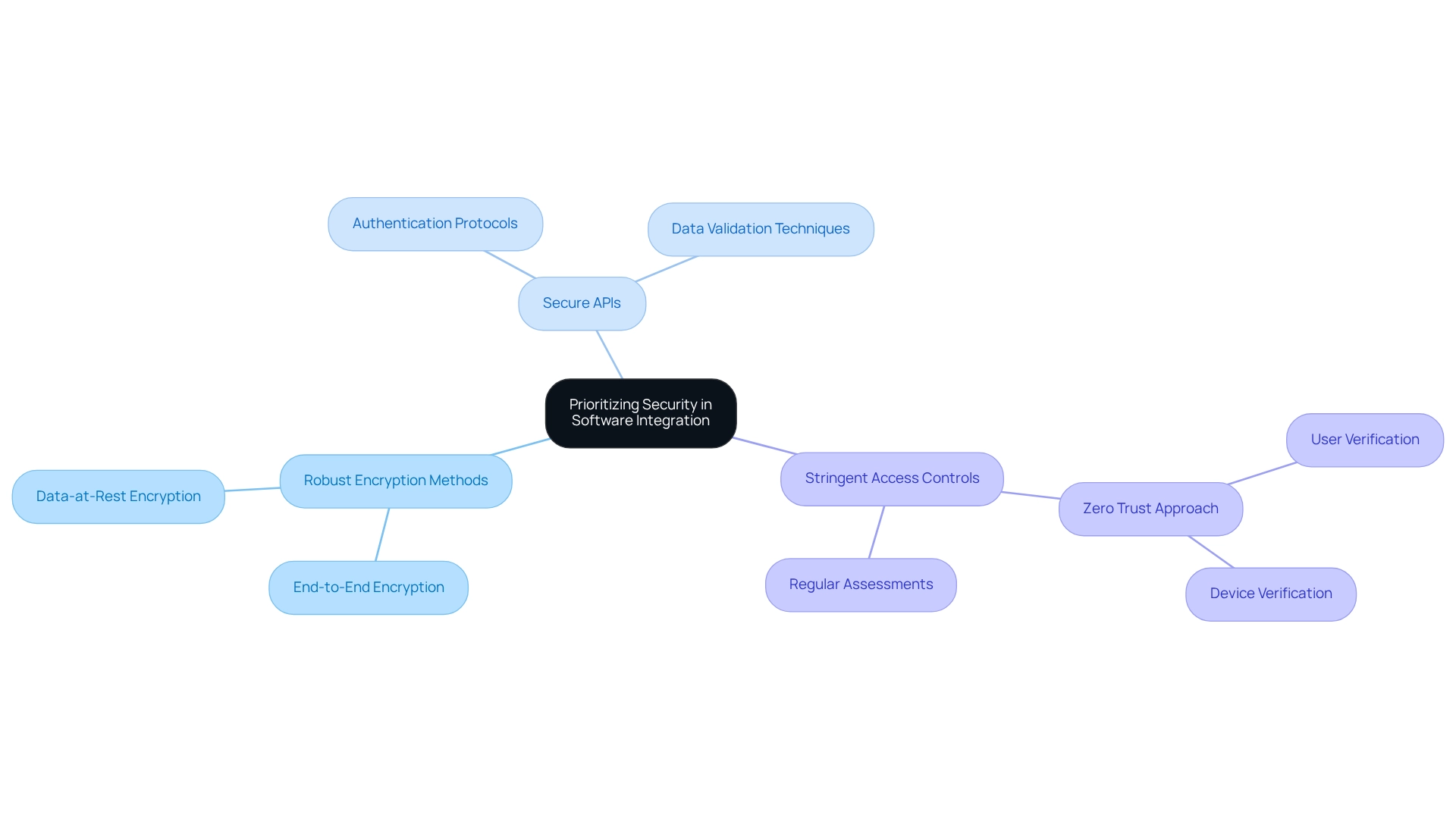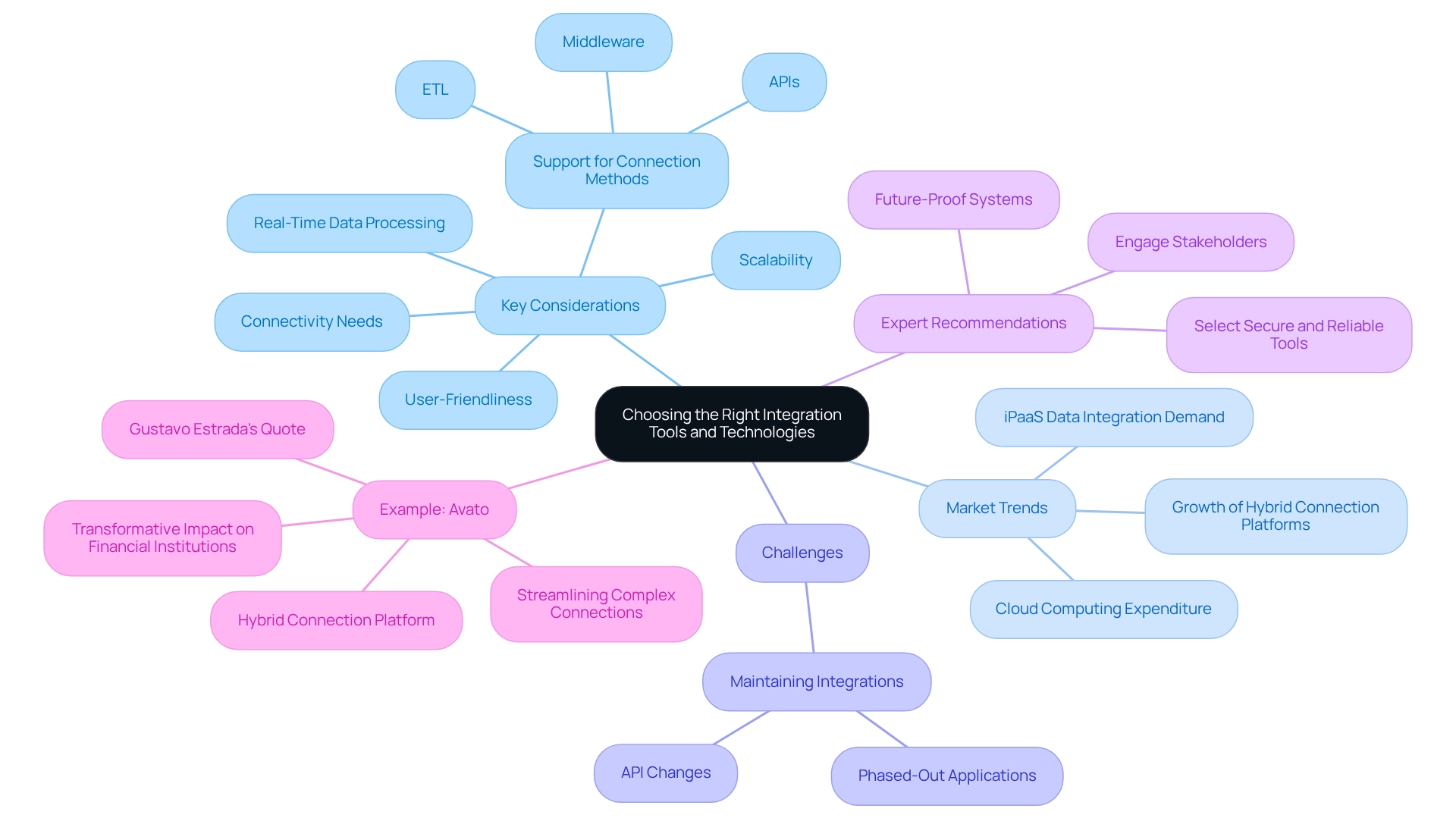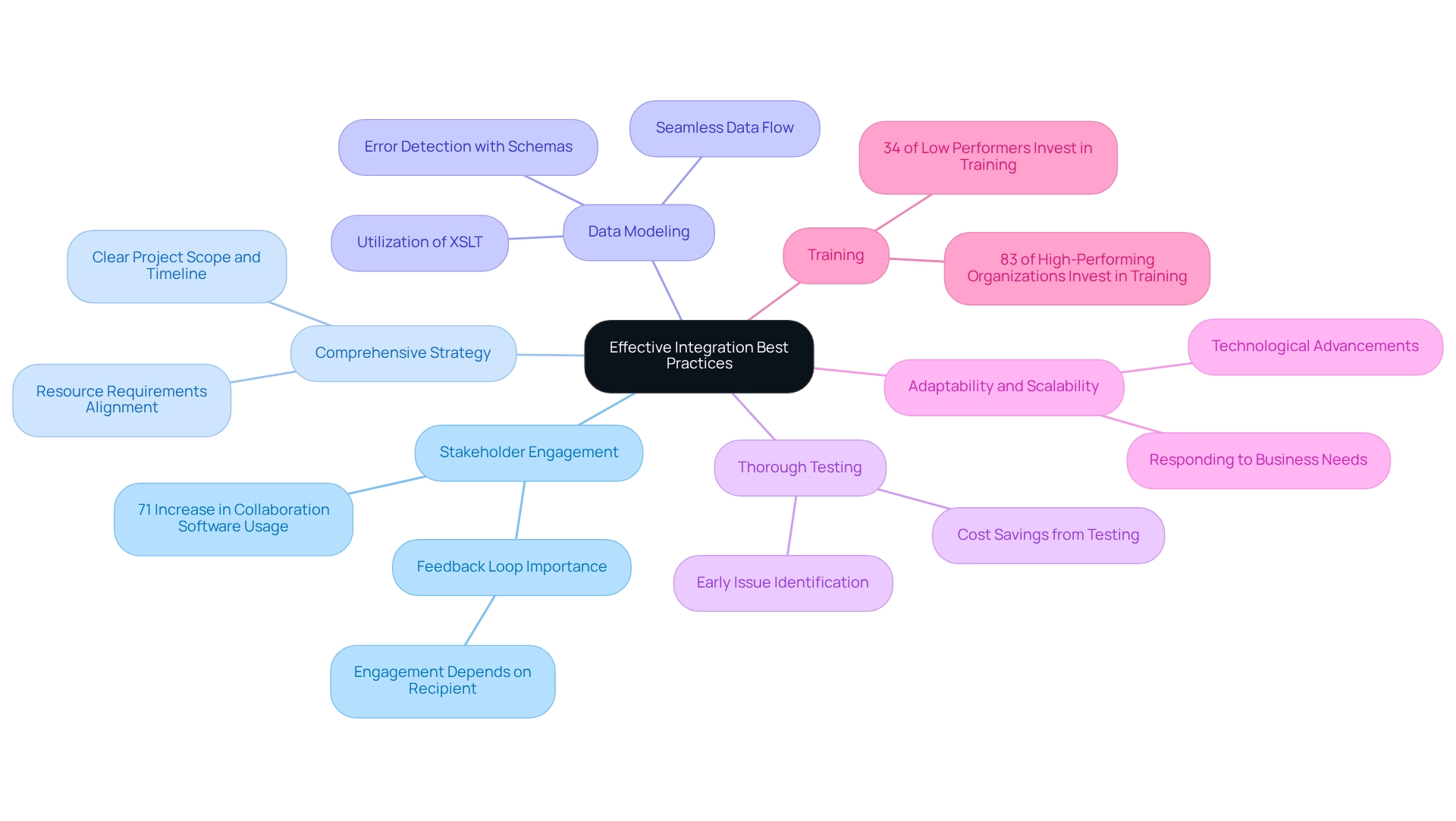Overview
Best practices for integrating software systems are pivotal in ensuring security and efficiency. How can organizations effectively safeguard sensitive data while achieving seamless integration? The answer lies in:
- Stakeholder engagement
- Robust planning
- Strategic use of appropriate technologies
Involving all key stakeholders and developing a comprehensive integration strategy significantly enhances project success rates. Furthermore, the emphasis on security measures—such as encryption and Zero Trust frameworks—cannot be overstated. These measures are essential to protect sensitive data during the integration process and should be a priority for all organizations. Adopting these practices not only mitigates risks but also positions organizations for long-term success in an increasingly complex digital landscape.
Introduction
In the digital age, where seamless connectivity and operational efficiency are paramount, software integration emerges as a critical component for organizations striving to enhance their performance. How can businesses connect disparate systems and applications to streamline operations, improve data sharing, and ultimately drive success? As the landscape of integration evolves, various methods—such as point-to-point, middleware, and API-based solutions—gain traction.
The challenge lies in selecting the right approach that aligns with specific organizational needs. Recent statistics reveal a significant trend: a substantial number of companies are investing in integration strategies to boost their performance metrics.
This article delves into the intricacies of software integration, exploring its importance, the necessity of robust security measures, the selection of appropriate tools, and the implementation of best practices that can empower organizations to thrive in an increasingly interconnected world.
Understanding Software Integration: A Comprehensive Overview
The integration of software systems is the essential procedure of linking various software applications and systems to operate seamlessly, crucial for entities aiming to streamline operations, enhance data sharing, and boost overall efficiency. In 2025, the landscape of connection approaches features point-to-point, middleware, and API-based linkages, each offering unique advantages and challenges. Selecting the appropriate method is vital, as it must align with the organization’s specific needs and existing infrastructure.
The significance of software unification is underscored by recent statistics, revealing that 67% of companies invest in such systems to enhance close rates, demonstrating a direct impact on business performance. Furthermore, 60% of Shopify app installations stem from customers exploring the marketplace, emphasizing the importance of connectivity in improving user engagement and operational efficiency. Notably, organizations employing middleware are increasingly favoring API solutions, indicating a shift towards more agile and adaptable connection strategies.
In the banking sector, the integration of software systems is paramount for achieving success. For instance, integrating a legacy core banking platform with contemporary customer relationship management (CRM) software can provide a cohesive perspective of customer interactions, significantly improving service delivery and operational efficiency. Avato’s Hybrid Integration Platform plays a crucial role in this integration, enabling companies to maximize and extend the value of their legacy systems while simplifying complex interactions.
A compelling case study reveals that numerous entities face challenges in maintaining connections, with 50% citing the cessation of linked applications or features as a significant concern. This highlights the ongoing necessity for vigilance in overseeing and adjusting integrations to ensure they remain valuable.
Recent trends indicate a growing reliance on solutions that support the integration of software systems, addressing current operational needs while future-proofing organizations against evolving demands. As Kelsey Johnson, Head of Marketing, observes, ‘67% of companies invest in connections to enhance close rates,’ emphasizing the critical role of such systems in achieving business objectives. Moreover, Typeform users with a Zapier connection are 40% less likely to disengage, illustrating the tangible benefits of effective connection strategies.
By modernizing their technology landscape, particularly in managing legacy systems, organizations can mitigate risks associated with digital transformation and bolster their competitive edge. The transformative impact of AI, as highlighted in the NVIDIA 2025 survey, further emphasizes the need for robust incorporation strategies that leverage advanced technologies to drive revenue growth and operational efficiency.

Prioritizing Security in Software Integration: Key Considerations
In the realm of software unification, prioritizing protection is essential for safeguarding sensitive information and ensuring compliance with industry regulations. Organizations must concentrate on several critical considerations, including:
- The implementation of robust encryption methods
- The utilization of secure APIs
- The establishment of stringent access controls
For example, employing end-to-end encryption guarantees that data remains confidential during transmission between systems, effectively mitigating the risk of interception.
Avato’s secure hybrid integration platform adeptly manages complex systems and is specifically designed to ensure 24/7 uptime and reliability—an absolute necessity in sectors such as banking, healthcare, and government.
Implementing a Zero Trust approach is another vital tactic that mandates verification for every user and device attempting to access the network, irrespective of their location. This approach holds particular relevance in the banking sector, where the average cost of a data breach can range from $5.86 to $6.08 million. Such a statistic underscores the financial ramifications of inadequate protective measures and highlights the critical need for a Zero Trust framework to protect sensitive information.
Regular assessments and vulnerability evaluations are indispensable practices that help organizations identify and address potential risks proactively. By integrating security into the merging process from the outset, businesses can significantly diminish the likelihood of data breaches and bolster their overall security posture. This proactive strategy not only protects sensitive information but also fosters trust among clients and partners, a factor of paramount importance in industries like banking and healthcare.
Moreover, with the average company sharing confidential information with 583 third-party vendors—82% of whom permit access to sensitive data—the significance of encryption and access controls in collaboration cannot be overstated. The recent surge in cyberattacks, exemplified by Poland experiencing over 1,000 attacks weekly in 2024, illustrates the escalating cybersecurity threats organizations face today. Additionally, companies have increased their budgets for protection by approximately 8.6% over the past five years, reflecting a heightened awareness of the necessity for robust protective measures.
As organizations navigate the complexities of software system integration in 2025, emphasizing protection will be crucial for maintaining operational integrity and shielding against evolving cyber threats. As Gustavo Estrada, a customer, remarked, ‘Avato simplifies complex projects and delivers results within desired time frames and budget constraints,’ underscoring the importance of effective security measures in achieving successful implementation outcomes. Avato, born from a commitment to solving intricate problems, is poised to support organizations in their digital transformation efforts.

Choosing the Right Integration Tools and Technologies
Choosing the appropriate tools and technologies is crucial for the successful integration of software systems. Organizations must evaluate these tools based on their specific connectivity needs, scalability, and compatibility with existing frameworks. Key considerations for integrating software systems include user-friendliness, support for various connection methods such as APIs, ETL, and middleware, as well as the capability to efficiently manage real-time data processing.
For instance, hybrid connection platforms like Avato, which translates to ‘of dedication’ in Hungarian, excel in linking legacy systems with modern applications. This capability enables faster deployments and minimizes downtime. Avato’s commitment to architecting technology solutions has proven transformative for financial institutions, as demonstrated by its successful implementations since 2010. The platform not only streamlines complex connections but also enhances business value by integrating software systems that unlock isolated assets, allowing companies to respond swiftly to market demands.
In 2025, the market for hybrid connection platforms is projected to capture a substantial share, driven by the increasing need for seamless data connection solutions. Notably, the demand for data unification solutions within iPaaS is expected to experience the highest growth rate between 2024 and 2032. This trend underscores the significance of integrating software systems and selecting the right tools.
Moreover, organizations should prioritize tools that offer comprehensive monitoring and analytics capabilities. These features enable them to assess unification performance and proactively address potential challenges. Statistics indicate that by 2024, cloud computing will account for more than 45% of IT expenditure on system infrastructure and associated software, highlighting the growing reliance on connection tools and the vital role of hybrid connection platforms like Avato in this context. Furthermore, a recent report reveals that 50% of enterprises face challenges in maintaining connections due to phased-out applications or features. This emphasizes the necessity for robust solutions capable of adapting to such operational challenges, particularly in sectors like banking and healthcare.
By thoughtfully selecting the right connection tools, organizations can enhance their connectivity efforts, reduce operational costs, and significantly improve overall efficiency through the integration of software systems. Expert recommendations advocate for platforms that not only simplify complex connections but also ensure security and reliability. As Gustavo Estrada noted, Avato is recognized for its ability to streamline complex projects and deliver results within desired time frames and budget constraints.
Furthermore, organizations should engage stakeholders effectively to ensure requirements are accurately captured and future-proof their systems to accommodate new tools alongside current assets. By leveraging these insights, organizations can make informed decisions that align with their unification objectives.

Implementing Best Practices for Effective Integration
To achieve successful software unification, companies must adhere to several best practices that enhance both security and efficiency. A fundamental step is the active involvement of all key stakeholders in the planning process. This engagement is critical for aligning objectives and expectations, ultimately resulting in higher success rates in project outcomes.
Statistics reveal that 71% of project management experts have noted an increase in collaboration software usage within their organizations over the past year, underscoring the growing recognition of stakeholder engagement in planning.
Moreover, contracting authorities in Croatia must establish systems for project execution and stakeholder involvement as part of governance, emphasizing the necessity of organized methods in collaborative projects. Developing a comprehensive unification strategy is equally essential. This strategy should clearly delineate the project’s scope, timeline, and resource requirements, ensuring all parties are aligned.
A well-defined strategy not only streamlines the assimilation process but also mitigates risks associated with project delays and budget overruns.
Proper data modeling is another vital practice. It guarantees that data flows seamlessly between systems, maintaining its integrity throughout the unification process. Utilizing XSLT, a pivotal feature of Avato’s hybrid unification platform, can significantly enhance this aspect, as it is a highly-tuned declarative programming language that simplifies the transformation and extraction of XML data, thereby reducing the labor involved in these tasks.
Furthermore, employing schemas alongside XSLT can detect programming errors early, leading to considerable cost savings and improved project outcomes.
Organizations should prioritize thorough testing at every phase of incorporation. Early identification and resolution of issues can avert costly setbacks and ensure a smoother transition. Additionally, preserving adaptability and scalability in connection solutions is paramount.
This adaptability empowers entities to respond effectively to evolving business needs and technological advancements. Successful stakeholder engagement is exemplified in case studies, such as “Critical Stakeholder Segments: Tailoring Engagement Strategies,” which discusses the necessity of developing tailored engagement strategies for different stakeholder segments to maximize their contributions and drive success.
Moreover, it is noteworthy that 83% of high-performing entities invest in project management training, compared to just 34% of low performers, highlighting the critical role of training in successful projects. By implementing these best practices, including the strategic use of Avato’s XSLT and schemas, organizations can significantly enhance their integration of software systems, fostering innovation and operational efficiency in an increasingly complex digital landscape. Quotes from contractors further emphasize that engagement depends on the recipient, reinforcing the importance of a feedback loop in stakeholder involvement.

Conclusion
Software integration stands as a critical pillar for organizations aiming to amplify efficiency and data sharing in an increasingly interconnected landscape. By grasping various integration methods—such as point-to-point, middleware, and API-based solutions—businesses can strategically select approaches that align with their specific needs and infrastructure. The substantial investments made in integration underscore its significant impact on performance metrics, including enhanced close rates and elevated user engagement.
Security emerges as a paramount consideration in the realm of effective software integration. Organizations must adopt robust security measures, such as:
- encryption
- secure APIs
- stringent access controls
to safeguard sensitive data and ensure compliance. A proactive stance on security not only mitigates risks but also cultivates trust among customers and partners, particularly in sensitive sectors like banking and healthcare.
Choosing the right tools and technologies is vital for successful integration. Organizations should prioritize platforms that deliver:
- scalability
- user-friendliness
- compatibility with existing systems
Hybrid integration platforms, in particular, excel at bridging legacy systems with modern applications.
By adhering to best practices—engaging stakeholders, crafting detailed strategies, and executing thorough testing—organizations can significantly enhance their integration outcomes. Maintaining flexibility and scalability remains crucial for adapting to the ever-evolving demands of the business landscape.
In conclusion, software integration serves as a strategic enabler for success in the digital era. By emphasizing security, selecting appropriate tools, and adhering to best practices, organizations can fully leverage the advantages of their integration efforts, drive innovation, and achieve operational excellence.

